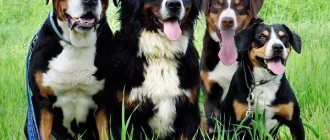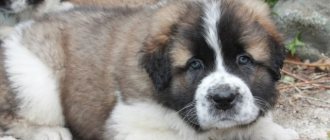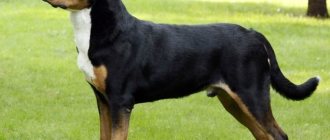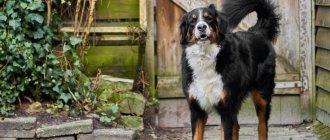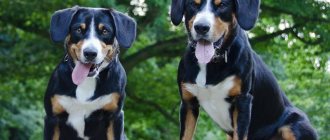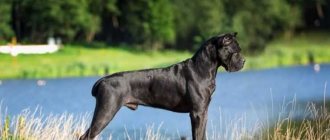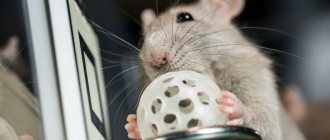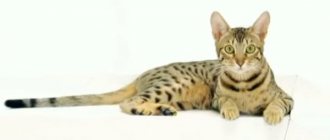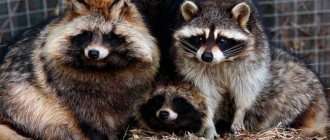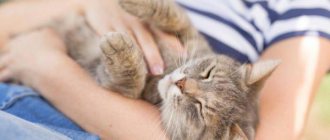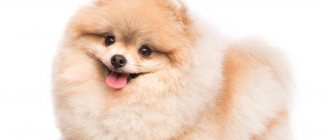Cheerful and affectionate, self-confident and smart, active and sociable - if you are looking for a dog with these characteristics, then the Appenzeller Mountain Dog is the one for you. He is very trainable. But there is one feature - the tendency towards dominance inherent in the breed. A dog needs a powerful, strict, but fair owner. If the attitude is too soft and lack of education from an early age, the puppy will grow into a real bully.
- 2 Table: breed requirements according to the official FCI
2.1 standard Photo gallery: Appenzeller appearance
Breed characteristics
| Short description | |
| Origin: | Eastern Switzerland |
| Conditions of detention: | Private house with a large yard |
| Purpose: | Shepherd dog, designed to guard livestock, an excellent watchdog |
| Color: | The animal has a pronounced tricolor, the color is black turning into tan, there are white markings |
| Wool length: | Good density, short and stiff |
| Adult dog size: | Females reach from 45.7 to 53.3 cm, males vary in size from 50.8 to 58.4 cm. On average, the weight of a pet is from 18.15 to 31.76 kg |
| Average life expectancy: | 10-14 years |
| Walk: | Spend your free time outdoors as often as possible. Mandatory: 2 times for 2-3 hours |
| Physical activity needs: | For this breed it is necessary to provide special sports activities. From an early age, get used to carrying heavy weights and running well. |
| Fédération Cynologique Internationale (FIC) classification: | Breed standard 46, FCI classification: Group 2. Pinschers and schnauzers, Molossians, Swiss Cattle Dogs and other breeds. Section 3. Swiss Mountain Cattle Dogs |
| Puppy price: | On average 20-30 thousand rubles. If a pet is needed for an exhibition, its price will be 60 thousand rubles. |
News
Following in the footsteps of Swiss cattle dogsIf we want to trace the origins of the four breeds of Swiss Cattle Dogs: the Bernese Mountain Dog, the Appenzeller, the Entlebucher and the Greater Swiss Mountain Dog, we must go back almost a hundred years and search in the remote valleys of the Swiss Alps, as geologist Albert Heim once did.
This professor from Zurich can rightfully be called the father of Swiss cattle dogs. Without him, selective breeding of these four recognized breeds may not exist today.
The great merit of the Swiss professor is that in the dogs of Alpine farmers, shepherds and butchers he saw the precious heritage of ancient hard-working breeds of dogs with a strong character, and that, thanks to the significance of the position he occupied as a scientist, he was able to propagate his opinions and ideas about these breeds.
Until the turn of the century, even in Switzerland itself there was no talk of any purposeful breeding of Swiss herding dogs.
This is not surprising, because only very wealthy people could afford to have a dog for entertainment and were willing and able to pay a fair amount of money, for example, for a trained herding dog. Of course, peasants, artisans and traders have long had dogs, but they simply belonged to their household and household equipment and were used as watchmen, shepherds and traction power. It never occurred to anyone to pay even one coin for such an animal. However, they were aware of their character and physical qualities.
During matings, they took into account the desired hereditary qualities of the dogs' parents and took care, of course, without having today's knowledge about the psychology of animals, about the conscious upbringing and training of dogs. However, the criterion for this was the ability and efficiency of herding cows, reliable guarding or harnessing draft dogs, strong as a bear, to the cart harness. No one needed non-beneficial eaters.
From farmer's dog to fashionable dog
Heim, Schertenleib, Silber, Strebel - these are the names of people who, for many years, tirelessly searched throughout Switzerland for dogs suitable for breeding that would meet their ideas about new breeds, set breeding goals and organized the first exhibitions of Swiss herding dogs. To be fair, in this regard it is also necessary to mention the name of the master from Bern, Heinrich Schumacher, who is the founder of modern St. Bernard breeding. Although the St. Bernard does not belong to the modern Swiss herding breeds, its close relationship with the large Swiss shepherd dog is undeniable.
There are now more than 400 dog breeds in the world. Among the most beautiful among them, dog lovers consider the Swiss Cattle Dog, all four breeds led by the Bernese Mountain Dog. The aura of this magnificent dog with lively, dark brown eyes, shiny black fur, a wide white chest like a scarf with an ornament, undoubtedly illuminates its owner. Therefore, the Bernese Mountain Dog became fashionable first of all. Unfortunately, this herding dog often has the fate of being just a decorative addition to many villas and country residences. Nothing more senseless can be imagined. After all, under the extravagant appearance hides a real “workaholic” by nature and origin, a dog who loves to work and follow commands more than anything else. The same applies to its alpine relatives. None of the four breeds of Swiss Cattle Dogs are designed to be couch potatoes or couch cushions. They are constantly looking for work and employment.
Comparison of Swiss Cattle Dogs
One thing is absolutely clear: the Alpine quartet, in terms of origin and appearance, can have much in common, while each of these four breeds, thanks to balanced and careful breeding, has developed a unique and irreplaceable individuality. This fact provides an opportunity to make a choice between these four breeds in order to acquire a completely unique friend.
The Greater Swiss Cattle Dog must thank for the existence of its breed exclusively the professional eye of Professor Heim, before whom at one of the exhibitions, together with the Bernese, a beautiful, very stately, but short-haired specimen was presented. This “impressive guy” was in no way inferior to the long-haired Bernese herding dogs. Albert Heim understood this immediately. At the same time, he remembered the butcher's dogs that he had seen several years ago in various places in Switzerland, and christened the exceptional show dog simply the Great Swiss. It was 1908. This was the year the Greater Swiss Mountain Dog was born. It was obvious that the Greater Swiss and the Bernese were closely related to the St. Bernard.
The Appenzeller and Entlebucher Mountain Dogs are more distantly related to the Bernese and Greater Swiss than the Saint Bernard.
The Appenzeller Mountain Dog was and remains a working dog.
Fast, unusually hardy, an outstanding shepherd and watchman, modest and quick-witted. A clear identifying mark of this slightly smaller than average, short-haired cattle dog is its "postman's pipe" - a tail that is rounded and tilted to the side. In the early stages of the development of this breed, when the transition between it and its closely related Entlebucher Mountain Dog was smooth, Appenzeller carried his tail absolutely normally. For the modern Appenzeller, a curled tail is prescribed as standard, as is a friendly roguish facial expression, which clearly provides him with a likability bonus.
The Entlebucher Mountain Dog is not inferior in efficiency to the Appenzeller, which sometimes you don’t want to believe when looking at this smallest of the four dog breeds, but this is in vain, and this fact is constantly emphasized by experts.
This confident, restless and muscular "ball of energy" is the "perfect guy." There is no doubt that this breed, which is quite problem-free from the point of view of the owner, has great prospects in the future. Sometimes these dogs were, and still are, used for military and border service. in terms of efficiency it does not lag behind Appenzeller, which sometimes you don’t want to believe when looking at this smallest of the four dog breeds, but this is in vain, and this fact is constantly emphasized by experts.
This confident, restless and muscular "ball of energy" is the "perfect guy." There is no doubt that this breed, which is quite problem-free from the point of view of the owner, has great prospects in the future. Sometimes these dogs were, and still are, used for military and border service. The Bernese Mountain Dog is in no way inferior to other breeds of Swiss herding dogs in its versatility and adaptability to family life.
His original field of activity as a guard, herding and working dog on rural farms still defines his personality and character. An easy-to-manage working dog today becomes an even more perfect family friend. The Bernese Cattle Dog is an absolutely first-class, reliable friend and protector of children, a guardian for the whole family and a pleasant life partner. is in no way inferior to other breeds of Swiss cattle dogs in its versatility and adaptability to family life.
His original field of activity as a guard, herding and working dog on rural farms still defines his personality and character. An easy-to-manage working dog today becomes an even more perfect family friend. The Bernese Cattle Dog is an absolutely first-class, reliable friend and protector of children, a guardian for the whole family and a pleasant life partner. Typical herding dogs
Swiss Cattle Dogs are the “strong type” in every sense of the word. This means not only their stately figure, but also the strength of their reliable and uncomplicated character.
Graze and guard
Both are in the blood of herding dogs. Today they can no longer directly prove this, except for those few who still help the Alpine shepherds and other inhabitants of the Alps to work. However, conclusions can be drawn based on how a herding dog behaves in its family. An example of this is a family walk. As long as everyone on the walk stays together, the mountain dog thinks everything is fine. As soon as someone lags behind, his inherited talent awakens - he circles around the group without stopping and runs from one family member to another with his tail raised defiantly. The dog will calm down only when everyone gets together again.
In two smaller breeds of herding dogs, Appenzeller and Entlebucher, the herding instinct - to herd and guard - is even more developed, even excessively.
The duty of herding cows has been the main responsibility of every herding dog for many generations. Although the selection was not purposeful, the peasants bred mainly champion shepherds with each other. This hereditary trait is deeply ingrained in the character of modern family Mountain Dogs, who, in most cases, do not have jobs. It is believed that among Appenzellers and Entlebuchers, more than ninety percent of puppies are born with this quality, or at least have a tendency towards it. For Greater Swiss and Bernese Cattle Dogs the percentage is slightly lower.
Gathering animals and people in one place and circling around them is an innate quality of herding dogs, as well as “grabbing the heels” of all real and virtual protected objects.
Making independent decisions
A typical character trait of Swiss Cattle Dogs is independence in decision making. They need to have this ability in order to be a reliable assistant in their work. In most cases, they navigate the situation much faster than any shepherd and act accordingly.
Thus, if one is looking for a four-legged guide that will respond with all the devotion of a dog to the word or gesture of its owner, one should not count on the Swiss Cattle Dogs. Despite all their great love for their family, most of them will never turn out to be quiet and unquestioning executors of the master’s commands. They are mainly reliable and understanding companions. Their upbringing should correspond to this: calm, without drill or raised voices, but certainly consistent and firm.
Instincts of a watchman and a security guard
They clearly belong to the inherited “baggage” of the shepherd. Herding dogs are the most selfless watchdogs imaginable. Under the protection of both large breeds, the Bernese and the Greater Swiss Cattle Dogs, a small child in the family grows up in absolute safety. When guarding, and, if necessary, protecting the house and plot, Swiss shepherds act without hesitation. Moreover, they can be entrusted with the targeted protection of any item.
Use this quality if your pet does not like to be left alone at home, and every time he demonstrates this quality, in the event of your absence, by some act of vandalism. Resort to a calming trick: before leaving home, assign him to guard some object - preferably something that reminds him of his owner, for example, a briefcase or old trousers. In this case, a proud security guard performing a particularly important task will simply no longer have time for all sorts of outrages.
Shepherd the flock
The herding dog, when not used for work, considers its mission to be the search for members of its human family. She feels good if her “human” herd is near her. Every evening they can clearly count the heads of all their loved ones and are satisfied only when every single one is collected. Thus, based on their nature, Swiss shepherds can be classified as dogs that love crowded company. And this quality is rooted in their peasant past.
The peasants generally did not have time to take care of their dogs.
. The dog belonged to both the household and the family. It was necessary that he obey all family members and be friendly to everyone. Of course, today Entlebuchers or Appenzellers do well in a family consisting of one person, but they are truly happy only in a large family, as in the old days. It is also completely understandable that for a dog that has always lived with other animals -
small and large - a harmonious partnership with other pets will not be a problem.
Even versatile talents need nurturing
The thought of the many-sided inherited qualities of Swiss cattle dogs sometimes leads to the opinion that puppies are born already “trained”.
This incorrect and dangerous opinion can lead to the fact that the young dog does not receive the necessary education. With appropriate training, the Swiss Cattle Dog will become an incredibly multi-talented dog, and, being a useful dog, can find a variety of uses: from a sanitary and search dog in avalanche conditions to a security guard and a guide dog.
History of the origin of the species
The Appenzeller Sennenhund or Appenzeller Sennenhund is one of the ancient dogs originally from Switzerland. The breed began to be mentioned in the mid-19th century, but the dog gained popularity in 1900. The moment of recognition of the Appenzeller is considered to be 1916.
After crossing Molossians with northern dogs, an excellent breed was obtained - the Appenzeller. Several theories have emerged about the origins of the ancient breed. One says that the Appenzeller was an Alpine dog. Thanks to archaeological excavations, the remains of Spitz-shaped dogs that lived a thousand years ago in the Alps have been found.
After genetic research, it was revealed that the breed originated from huge dogs with light coat color. These dogs helped guard livestock, they helped farmers overcome long distances, and they also protected the home and family members. All Swiss Cattle Dogs have the same ancestor, but there is no definitive proof of this.
Since ancient times, there was a complex connection between the two valleys in Switzerland, so the dog population in the neighboring cantons was not similar to each other.
By all accounts, it is known that several dozen different Sennenhunds have appeared, and for hundreds of years they have been excellent assistants in farming.
Appenzeller Mountain Dog: a brief description of the breed
Few people know that this breed was originally used for guard purposes. Since the dog was bred in the Swiss Alps, where cattle breeding was rapidly developing, the spirit of the shepherd was inherent in the pet from birth.
Advertising:
Later, the Appenzeller Sennenhund breed began to be actively presented at international exhibitions due to its pleasant and impressive appearance. From that moment on, the fame of such pets spread throughout many European countries, and Appenzeller turned from a shepherd dog into a pet.
For a better idea of what this breed looks like, below is a photo of the Appenzeller Sennenhund.
As you can see, this is a large dog with a developed and powerful chest, strong paws and a muscular build. An adult Swiss can reach a maximum height of 58 cm and weigh 32 kg. Such dimensions allow you to keep an animal both in a private house and in an apartment.
The color of this breed is always elegant, as it appears in three colors: black, white and red.
A famous variety of Mountain Dogs is the Bernese, which can be seen in the video
Distinctive features
The Appenzeller Mountain Dog is not like other dog breeds; it has its own distinctive features:
- The body has a strong body.
- The head is proportional in shape, the skull is flat. Cheekbones are poorly defined.
- The bite is scissor-shaped.
- The eyes are small, almond-shaped, and have a smart look and a mischievous expression. Among the characteristic colors there are only black or brown.
- The ears are usually triangular in shape with a rounded part downwards, the base is wide, located close to the cheeks.
- The tail does not exceed medium size, it is low set, and due to its good curl, there is no visible hole in the center. During movement of an individual, the tail falls over the back or to the side.
- The coat is divided into two layers. The upper spine has good density, there is a shine on the surface, sometimes there is a slight waviness, it occupies the area of the withers or back. The bottom layer consists of black color, in addition there is brown and also gray, usually it is not visible through the awn.
Breed standards and character
The Appenzeller breed must meet the following requirements:
- General appearance: a medium-sized dog with a tricolor color. The body format is closer to a square, all parts of the body are proportional. Strong, energetic, eyes look confident.
- Mandatory proportions: the ratio of the height at the withers to the length of the body is 9 to 10, the ratio of the length of the muzzle to the length of the skull is 4 to 5.
- The head is wedge-shaped and fits perfectly with the body. The top line is flat, the greatest width is between the ears, becoming evenly narrower towards the nose. The stop is barely noticeable. Powerful lower jaw.
- The lips are pigmented black or brown, repeating the main color, as well as the nose and the edges of the eyelids.
- The teeth are strong, the bite is correct, “scissors”. Although "pincers" are also allowed.
- Cheekbones are barely pronounced.
- The eyes are not protruding, medium in size, dark brown or hazel. The look is calm, attentive.
- The triangular-shaped ears calmly fall on the cheekbones; in excitement, the dog raises them as much as possible and turns them forward. Together with the head, they form a pronounced triangle in shape.
- The neck is powerful, short, straight.
- The back is straight, the lower back is strong.
- The chest is voluminous, the stomach is toned.
- The tail is set high and covered with hair. When moving, it turns onto its back in the middle or slightly to one side. When at rest, it simply hangs down.
- All paws are muscular, straight and parallel in pairs. The pads are hard. Running is smooth, with a powerful push of the hind legs.
- The coat is double, the guard hair is shiny and thick, the undercoat is not visible through it. The main color is black with reddish and white markings, as symmetrical as possible. Red spots appear on the cheekbones, chest, legs and around the eyes.
A white stripe runs along the entire head from the top between the ears to the tip of the nose. The throat and chest of the dog are marked in white in the form of a frill. There are white spots on the paws, the tip of the tail, and a mark on the back of the head is allowed.
Appenzellers have great physical strength
- The character is characterized by goodwill, courage and liveliness. The Appenzeller dog is a brave and reliable friend. He treats strangers with restraint and wariness. Easy to train, quick-witted. He is not suitable for the role of a “sofa toy”, but he will happily go for a run with you in the morning, do exercises, and can roll up a garden cart with tools or even with children.
He will never let strangers pass without a signal, moreover, he will bark until he is exhausted, but you will not move from your place until the owner arrives. But cats and all sorts of small animals are not interesting to him. The dog has a strong character, and he needs an owner to match him in order to put him in his place on time.
We must not forget about the genetic purpose of the animal. Although now he is widely used as a companion, he is a herding dog. Therefore, it may slightly “bite” the heels when playing with children.
Photo of an adult dog
History of the breed
Shepherd dogs are one of the oldest breeds in Switzerland
Breeding shepherd dogs is a traditional and integral occupation of the inhabitants of the Swiss Alps. The name literally translates as “shepherd’s dog.” Four types of animals of this branch have been recorded, but the Appenzell shepherd dog is considered the most entertaining.
Note! Appenzeller received documentary confirmation relatively recently - only at the end of the 20th century. But it is believed that the dog’s ancestors are mentioned in the annals of Ancient Rome.
Photos of puppies
Appenzeller puppies
If you decide to purchase an animal such as an Appenzeller Mountain Dog, a nursery is an ideal place where you can choose a puppy and immediately meet its parents in order to see the prospects of the young animal. It is also very important to see the conditions in which the puppy lived, since all this affects the future health of the pet. If you see that dogs are kept in improper conditions, then you should not take your pet to such a place. Unscrupulous breeders will most likely try to hide the baby’s health condition from you.
When choosing a dog, you should understand how to feed it properly. For example, two-month-old puppies need 5-6 feedings a day. And at the age of 3-4 months, food can be given four times a day. By eight months, the dog can be switched to two meals a day.
During puppyhood, pets urgently need cottage cheese, eggs, and fermented milk products. But overfeeding the animal is not recommended. Dogs need to be active or risk becoming obese.
Features of character and behavior
- In a large family, a pet most often finds its place. Owners love the dog for its devotion and affection. Representatives of the Appenzeller Mountain Dog breed spend time with all family members with great desire and pleasure.
- Separation is hard to bear. Due to high attachment, the animal becomes depressed. Dogs love all family members, but usually choose one person and get very used to him.
- Proper socialization allows you to treat children with tenderness and patience. It is not recommended to leave your pet near a very small child, as the young individual is excessively loud and active.
- The main duties of the dog for several centuries in a row are to perform guard functions . The breed is wary and suspicious of people unfamiliar to it. Thanks to proper socialization, representatives of this breed develop a high protective function. They, unlike other dogs, do not look at strangers as a serious threat.
Kinds
Sennenhunds are a group of dogs native to Switzerland. In addition to our hero, three more famous breeds are known. Greater Swiss Mountain Dog. Once an extremely sought after breed among Swiss shepherds. Descendant of imported mastiffs and local dogs. A large, strong animal with a heavy skeleton.
The Greater Swiss Mountain Dog has a balanced character and versatile working qualities.
At the withers up to 72 cm, weight up to 64 kg. The color is standard for herding dogs - black, white and red. The coat is hard and not long. They were often used to transport goods and people. Two harnessed dogs could pull the cart behind them. But the dog was not agile enough for farm work, so he was gradually replaced by other breeds and machines.
Bernese Mountain Dog. His native place is near the city of Bern. After several centuries of spontaneous breeding, in 1902 one specimen was presented at a famous exhibition. And the Swiss seemed to have their eyes opened - already in 1907 a standard was set for them, a club was organized, and in 1910 107 purebred dogs were presented to the public.
The coat color is not original - black with white and red. But the structure of the fur is completely different - long, shiny, silky hair. This was probably due to the Newfoundland genes that were added in 1949. Standard height is 63-68 cm, weight 48-50 kg.
The Bernese Mountain Dog is a gentle and charming giant, unusually peaceful
Entlebucher Mountain Dog. If you place all the Mountain Dogs in a row, then the first in height is the Greater Swiss, and the last in the line is this dog. He is the smallest of all. Height up to 50 cm, weight approximately 25 kg. Need I say that the color is no different?
The same black, white and red color scheme. And, despite his size, and perhaps precisely because of this, he is the most temperamental of all. If the big brothers, aware of their status, are distinguished by confident calm and good nature, the smallest is full of energy and always on the alert.
If you are looking for a pet with whom you can share an interest in sports records, then this is the Entlebucher.
Advantages
Among the main advantages of the breed are loyalty and affection . The dog is an excellent watchman and security guard who is not afraid of anyone. The dog does not need special care, basic care is enough.
Advantages of the breed:
- equilibrium;
- confidence;
- instant response;
- devotion.
The pet is not just an excellent guard, but also a devoted watchman. A stranger will not move through its territory. The dog will quickly pay attention to him and will drive him out of his place with all his might.
Flaws
- Among the disadvantages, severe shedding stands out. The pet must be constantly brushed due to the rapid change of hair, otherwise the dog will become restless.
- Appenzellers must be subjected to constant physical activity . If this is not done, they may get sick and become unsightly.
Character
The Swiss Mountain Dog Appenzeller is distinguished by its activity, energy, strength and kind, flexible character. He is very smart and always tries to understand what the owner requires of him, so he is suitable for a dog owner without experience.
Let's look at the positive traits of a pet and why it should be chosen for home keeping:
- The breed easily and quickly adapts to any conditions: both outdoor and indoor.
- He is loving and stands out for his special devotion not only to one owner, but also to the entire family in which he grows up.
- This is a cheerful dog who is always ready to learn everything new, including tricks and tricks, so life with him will not seem boring.
- Loves children and gets along well with other animals.
- Rarely shows aggression and only in cases of insecurity.
This self-sufficient dog is also prone to dominance, which is not always to the owner’s liking. To avoid disobedience, you need to show your authority in advance.
Care and maintenance
One of the easy tasks is caring for a dog. Caring for the Appenzeller Mountain Dog consists of the following procedures:
- Combing once a week. This will help maintain the neat condition of the coat;
- Occasionally it is allowed to bathe your pet using a special shampoo recommended by a veterinarian;
- Trimming nails as needed;
- Brushing your teeth with a special brush or bone;
- Regular examination of the condition of the ears , as infection often accumulates in them.
Content Features
The Appenzeller Mountain Dog is suitable for living in an apartment, provided that it is provided with plenty of games and regular walking. However, a more suitable option for a dog would be to live in a private house with a fenced area, where it can walk to its heart’s content and, of course, work - guard it. Aviary keeping is excluded, due to the fact that the dog needs close contact with humans.
In winter, the Appenzeller is overgrown with a thick, warm undercoat, so it does not need additional insulation.
Appenzeller needs good exercise. He cannot be content with a short walk twice a day; he needs jogging, games, and, in the warm season, swimming. No less important is mental stress - learning new commands, active games of search and ingenuity.
The Appenzeller Mountain Dog has long been relegated to the category of companion dogs and is rarely used for its intended purpose, as a herd dog. Some owners, for the general development of the pet and their own interest, teach it this craft. Playing sports will also help you release your energy in a positive way.
Appenzellers show good results in frisbee, canicross, agility and other competitions.
Care
Grooming a short-haired dog is not difficult. The coat is brushed 1-2 times a week, and sometimes less often. During the molting period, you can do it daily. Monitor the condition of the eyes and ears, which are cleaned as needed. Claws, if they are not worn down during walks, are trimmed as they grow. The frequency of bathing may vary depending on the dog's living conditions and skin type. The detergent is selected individually. It is useful to accustom your Appenzeller to regular teeth brushing, which will be a good prevention of dental problems in adulthood.
Nutrition
There are no special requirements in terms of feeding the Appenzeller Mountain Dog. Most breeders and owners prefer to feed their dogs dry industrial food above the super-premium class. This makes it much easier to provide a nutritious diet. If desired, you can accustom your pet to natural food. At the same time, at least 50% of the menu should be allocated to meat and offal, the rest includes cereals, dairy products, vegetables and fruits. Every day the diet is supplemented with vegetable oil and a little bran. Once or twice a week they give an egg and lean sea fish. Natural nutrition involves the introduction of vitamin and mineral supplements in short courses during the period of active growth and in the off-season.
As for food, the Appenzeller is suitable for diets designed for active small breed dogs. Regardless of the type of food, clean drinking water should always be freely available.
Most Appenzellers are big eaters and snackers, so it is important for owners to monitor the size of their portions and the calorie content of their food. Without good physical activity, dogs quickly gain excess weight.
Nutrition
A dog of this breed is unpretentious in feeding; it eats everything that its owner gives it. From an early age, you need to develop a proper diet for your puppy. While he is small, feeding your pet at regular intervals will not hurt to create a feeding schedule.
- The puppy grows quickly from raw and cooked meat . When the pet is 3 months old, soups are introduced into its diet and dairy products are fed 2 times a week. Upon reaching of 4, dairy food is given only once a day.
- From 2 months you can introduce vegetables into the diet: boiled cabbage and beets. An adult dog can eat raw cabbage. Once a day at the age of 1-2 months, a boiled egg is given, but when the pet matures, it can be given eggs no more than 2 times a week.
- An adult dog is fed at least 2 times a day. The bowl should be removed after feeding. Fresh water should always be present in other clean containers.
Prohibited additives:
- Salty food.
- Fatty foods.
- Pork and lard.
- Semi-finished products, sausages and sausages.
- Chocolate can cause a fatal blow; it is also not suitable for nutrition.
- Healthy ingredients include bones, lean meat, and boiled sea fish.
Rules for healthy eating:
- It is allowed to give pets fruits and vegetables, they contain many vitamins.
- The dog should always drink clean water, but not tap water.
- Animals should not be fed soups; they will develop a saggy belly.
- In winter, vitamins and microelements are added to the main food.
- It is useful to feed your pet dry food; they are selected according to age.
- At a young age, puppies are fed at least 5-6 times a day; nutritious food consists of eggs, fermented milk products and cottage cheese.
Health
In the modern world, representatives of this breed live on average from 12-14 years. In general, the dog is in good health; in addition, it is necessary to maintain good physical fitness. Thanks to high activity, the pet rarely gets sick.
Vaccinations
Before vaccination, anthelmintic treatment should be carried out.
- The first complex vaccine is given at 2 months , it is against several diseases.
After vaccination, the dog cannot be bathed. Overfeeding the animal should be avoided for two weeks. Walking is prohibited.
- Immunity develops within 12 days . You need to keep an eye on the puppy’s condition; the body weakens, the temperature rises, and diarrhea appears.
- The second vaccination is given after the first in the 3rd week, the same vaccine is used. This time, the dog tolerates vaccination more easily, but for 12 days it should not be allowed near other animals, protected from drafts, and should not go for walks.
When the puppy is six months old, he is given a rabies vaccination, as well as a complex vaccine.
Diseases
The following diseases are typical for this breed:
- hip joint disorder;
- improper formation of the elbow joint;
- visual impairment;
- stomach problems: churning;
- demodicosis may develop;
- the appearance of hemolytic anemia;
- epilepsy develops.
Walk
It is recommended to take an adult and healthy dog in an apartment living environment and walk it 2 times for 2-3 hours.
Regular walks are also necessary for representatives of this breed who live on a personal plot at least once a day.
The dog is actively involved in dog sports, he enjoys doing agility, and also loves to run. You can prepare obstacle courses for your pet, which he will be happy to go through.
Grooming
This breed sheds only twice a year . It is during this period that the wool needs special care. A special brush or glove is used for combing. Bathing is organized no more than once every six months.
They do not need to have their hair done or trimmed; once dirty, just wash and comb thoroughly.
Does the dog have a tendency to get sick?
The average lifespan of Appenzellers is 12–14 years. But in order for a dog to live as long as possible, feel good, and be able to participate in breeding purebred puppies, it must be checked from birth for the presence of hereditary diseases. The fact is that representatives of the breed are prone to:
- dysplasia of the hip and elbow joints;
- congenital weakness of the ligaments of the hind limbs, causing patella (dislocation of the kneecap);
- progressive retinal atrophy.
The listed pathologies can be eliminated, but on the condition that they are identified in the puppy at an early stage of development. If treatment is not carried out in a timely manner, complicated diseases will lead to irreversible consequences: dysplasia and patella will provoke a violation of the motor function of the damaged paw, and retinal atrophy will cause blindness.
Since the Appenzeller is active, strives to explore all the bushes and thickets, and roll in the grass, it is often diagnosed with piroplasmosis and other diseases, the source of which is a tick. To protect your pet from this parasite, you need to treat the animal with protective agents (for example, wash it with shampoos that contain herbal or synthetic insecticides), and after walks, check the dog for the presence of attached pests.
Another disadvantage of excessive dog activity is the high risk of injury during play. If your pet suddenly starts limping, licking its paw, or whining, you need to show the animal to the veterinarian and check for wounds, fractures, bruises, and dislocations.
Key points in training
- The Appenzeller breed is one of the most obedient dogs; they are smart and pick up all the skills. The breed occupies high levels in dog sports; it easily overcomes obstacles, as well as obedience competitions.
- Representatives of this breed can be attentive students, but there are also stubborn individuals among them . It takes a lot of patience to train such pets. This dog needs to be motivated with food and then praised generously for exercise.
- Read about how to properly train a dog in the article: “Training a puppy: effective methods from dog handlers, learning commands at home.”
Purpose of the breed
The name of the dogs of this breed comes from the word senn, which means shepherd in German. It is easy to guess that the direct purpose of the Appenzellers was to help herd and protect herds of cows and sheep on the green slopes of the Alps. Dogs also guarded farmers' farms, warning them with loud barks about the arrival of uninvited guests.
Currently, representatives of the Appenzeller Mountain Dog continue to carry out herding service in some areas of Switzerland. Thanks to their excellent sense of smell and attention, they can often be found in rescue and search teams.
They make good trackers and orderlies, as well as service dogs. But most often they are bred as companion dogs and as exhibition prize-winners. And the Appenzeller Mountain Dog can often be seen on the podium of winners of various dog competitions.
How to choose a puppy
- The choice of a puppy must be approached responsibly. First of all, you should pay attention to the parents, find out what they were sick with, and in what conditions they were kept. Studying your pet's history will help with future care.
- To purchase puppies, you can contact the nursery, where they will allow you to choose the dog you like. Many buyers turn to a professional breeder. He will introduce you to the breed and talk about its advantages and disadvantages.
It is recommended to buy puppies at the age of 2 months, by which time the pet will be stronger for life in another family.
History of the breed
The dog comes from the colorful Entlebuch Valley near Bern, Switzerland. The dog acquired its modern appearance over time. The ancestors of the Entlebuchs were Roman legionary dogs; they also arose from the Molossians, who stood out from their contemporaries for their large size and enormous fearlessness. The Molossians were known even before our era; they lived mainly with Aryan nomads. In tribes, dogs had to herd herds, guard them and, if necessary, protect them.
Important: Moloss is not a breed yet, but only a classification.
Individuals belonging to the Molossians performed various tasks depending on their place of life. The Entlebucher Mountain Dog's ancestors were guard dogs and shepherds, and they were also excellent warriors and companions.
In fact, entlebuchs date back to 1913, in which an experimental dog show took place. Until this time, the Entlebucher was classified with the Appenzeller. Albert Heim, an exhibition judge and breed expert, had a professional influence on the identification of the Entlebucher Mountain Dog as an independent breed and its inclusion in the register of breeding dogs in Switzerland.
Mr. Kobler opened the first breed club. This event took place in 1926. A year later, an official breed standard was formed. From that time on, breeding development began. Unfortunately, the pace of work does not allow everyone who wants to purchase this pet. Therefore, entlebuchers still remain difficult to obtain, but incredibly in demand.
Diet and diet
There are 2 food options - ready-made balanced dry food for dogs of large and medium breeds or natural food. In the second case, the diet consists of: lean meat, boiled sea fish, vegetables, cottage cheese, eggs, cereals.
Under no circumstances should you give:
- salty foods and those containing spices;
- fatty and smoked foods;
- semi-finished products;
- sweets.
Important! You cannot overfeed the Appenzeller. This threatens obesity, which can have a bad effect on the general condition of the body and lead to other diseases.
Advantages and disadvantages
| Positive traits | Negative qualities |
| devotion | need for a lot of physical activity |
| loyalty | intense shedding |
| good nature and complaisance | distrust and aggression towards strangers |
| high intelligence | |
| love for children | |
| fast training | |
| well developed working qualities | |
| high immunity |
The Swiss Appenzeller is a dog with many positive qualities.
If it is possible to keep her in a country house and ensure constant activity, you simply cannot find a better friend, companion, nanny and guard. *Prices are current as of November 2021.
